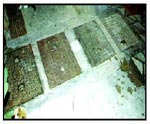-
 Sewerage Facts
Sewage • Sewage Characteristics • Sewage Treatment Objectives • Sewage Treatment Methods • Sewage Treatment System • The Evolution Of Sewage Treatment Sewage Treatment Plant • Package Plants • Combined Process • Imhoff Tanks • Oxidation Pond Effluent Standards Individual Septic Tanks Population Equivalents Water Cycle Confined Space Ammonia Green Technology Lighter Side
Sewerage Facts
Sewage • Sewage Characteristics • Sewage Treatment Objectives • Sewage Treatment Methods • Sewage Treatment System • The Evolution Of Sewage Treatment Sewage Treatment Plant • Package Plants • Combined Process • Imhoff Tanks • Oxidation Pond Effluent Standards Individual Septic Tanks Population Equivalents Water Cycle Confined Space Ammonia Green Technology Lighter Side - Technical Resources Center
-
 INDAH WATER RESEARCH CENTRE
INDAH WATER RESEARCH CENTRE
 Individual Septic Tanks is one of the simplest forms of sewage treatment and dates back to the sewerage system development in France in 1860.
Individual Septic Tanks is one of the simplest forms of sewage treatment and dates back to the sewerage system development in France in 1860.
An IST comprises two chambers connected in a series. In the first chamber, solids from the incoming sewage settle forming a "sludge", while greases and oils float to the surface forming a "scum" layer. Effluent from between the scum and sludge layers then passes into the second chamber where further sedimentation occurs. Finally, the effluent leaves the second chamber and is discharged into a drain or allowed to percolate into the soil.
The sludge in the tank undergoes anaerobic digestion and is converted into more stable organic compounds and gases such as carbon dioxide (CO2), methane (CH4) and hydrogen sulfide (H2S). ISTs are usually designed for a 24-hour retention time. Enough storage capacity is provided so that scum and sludge can be deposited in the tank for up two years after which it must be desludged to keep the tank operating satisfactory.
The sludge in the tank undergoes anaerobic digestion and is converted into more stable organic compounds and gases such as carbon dioxide (CO2), methane (CH4) and hydrogen sulfide (H2S). ISTs are usually designed for a 24-hour retention time. Enough storage capacity is provided so that scum and sludge can be deposited in the tank for up two years after which it must be desludged to keep the tank operating satisfactory.
ISTs are suitable for single dwellings or individual buildings with a population equivalent (PE) up to 150 and installed where there is no central sewerage systems and where effluent discharges will not adversely effect the environment. It is a cheap solution to disposing of sewage. However, ISTs only partially treat sewage and concentrated groups of tanks can overload the capacity of the receiving environment creating health and odour problems. There are currently over one million ISTs in Malaysia, making it by far the most common type of sewage treatment system.
Typical figures for ISTs are as follows: -
| (mg/L) | Raw Sewage | Effluent | DOE Standard B |
|---|---|---|---|
| Biochemical Oxygen Demand | 200-400 | 150-200 | 50 } not applicable to |
| Suspended Solids | 200-350 | 50-100 | 100 } ISTs |

- CUSTOMER : Please CLICK HERE to see how we handle your personal data
- Click CUSTOMER tab for more info on charges, services, check your account balance & statement of account request
- Click DEVELOPER tab for certifying agency offices, check submission status & get sewerage work-related forms
- Click CONTRACTOR tab for contractor & supplier online registration and IWK Technical Training Centre
- Your feedback is important to us. Please do not hesitate to contact us with your constructive comments.


